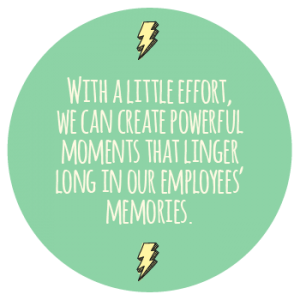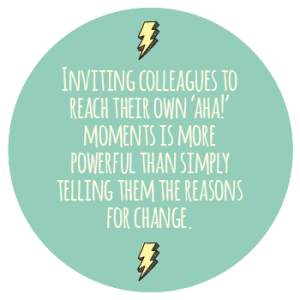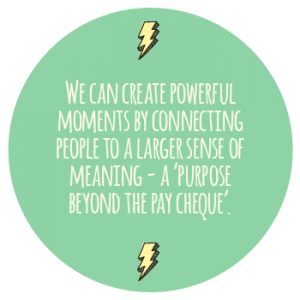If you look back on your working life, what memories stand out? Chances are you’ll remember specific moments that have come to define how you feel about a particular role or organisation.
We remember these moments so vividly because of what psychologists call the peak-end rule. When we review an experience after the event, we tend to focus on the best or worst moment – the ‘peak’ – and the ending. Everything else starts to blur.
These moments happen throughout our working lives, either by accident or design.
But if they have such power, why don’t we make more of them? Why do we miss so many opportunities to create meaningful moments that have an extraordinary impact on the lives of our employees?
That’s the question posed by Chip and Dan Heath in their book The Power of Moments.
According to the Heaths, defining moments at work tend to arise from:

- transitions – an employee’s first day at work, a promotion, the end of a project
- milestones – long service landmarks, retirement, the recognition of key achievements
- pits – employees facing bereavement, stress, or even a poor performance review
These moments create unique opportunities to transform the employee experience and build engagement, yet we often fail to take advantage.
With a little effort, we can create powerful moments that linger long in our employees’ memories. The recipe for success, according to the Heath brothers, involves one or more of the following ingredients…
Moments of elevation 
Defining moments rise above the norm. To achieve that, we have to ‘break the script’ and do something unexpected.
A study of hotel reviews on TripAdvisor, for example, found that 60% of guests who were ‘very satisfied’ would unconditionally recommend the hotel. But when guests reported experiencing a ‘delightful surprise’ during their stay, that figure jumped to 94%. The surprise had broken the norm.
High street food chain Pret A Manger artfully incorporates this principle into its customer service. Regular visitors will probably remember the first time they received a free coffee or pastry – the unexpectedness makes it memorable.
Rejecting the traditional loyalty card approach, Pret allows its employees to give away a certain number of hot drinks and food items each week. This random element not only creates more memorable moments for its customers, it breaks the script for Pret’s employees too. They get the power to decide whose day they’re going to make more special, while happiness research shows that the act of giving is itself a powerful booster of wellbeing.
Moments of insight
Moments of insight deliver a jolt: a sudden realisation that changes your outlook. While such moments often happen by chance, the Heaths offer two tactics for creating moments of insight.
First, invite colleagues to ‘trip over the truth’. This tactic is widely used in ‘big picture’ communication activities, where colleagues discover the need for change by exploring a graphical ‘roadmap’. Inviting colleagues to reach their own ‘aha!’ moments is more powerful than simply telling them the reasons for change.
Second, mentors can help colleagues ‘stretch for insight’. Self-understanding comes slowly to many of us, but mentors can nudge people to venture outside their comfort zone, creating moments of insight about their own abilities and ambitions.
As internal communicators we can help others reach moments of insight through informal mentoring or by taking part in formal mentoring schemes run by organisations like the Institute of Internal Communication (IOIC).
Moments of pride
The easiest way to create moments of pride, say the Heaths, is to offer colleagues recognition. Yet the power of recognition is still vastly underrated by many leaders.
Carolyn Wiley of Roosevelt University reviewed four studies of employee motivation carried out between 1946 and 1992. She found only one factor made the top two motivators every time: full appreciation of work done.
According to Wiley, more than 80 per cent of supervisors claim they frequently express appreciation, but less than 20 per cent of employees say their bosses do this more than occasionally. The Heaths call this the ‘recognition gap’.
Organisations often attempt to close this gap with initiatives like ‘Employee of the Month’ or annual awards. But these schemes can be selective, predictable and mechanistic.
Recognition works more effectively if you make it personal and unpredictable.
Even simple notes and gestures of appreciation can have an extraordinary impact. What’s important, say the Heaths, is authenticity. It’s about managers saying: “I saw what you did and I appreciate it.”
Moments of connection 
Internal communicators can create powerful moments by engineering opportunities to bring colleagues together and deepen the connections between them. Email, social networks and video conferencing allow us to work more remotely, so powerful moments of connection are increasingly about bringing colleagues together face to face.
Managers have an outsized opportunity to create powerful moments by strengthening their relationships with their team members. Relationship science suggests the key to building strong relationships in all areas of life, including at work, is to show ‘responsiveness’: understanding and validating an employee’s needs, and demonstrating you care about them.
We can also create powerful moments by connecting people to a larger sense of meaning – a ‘purpose beyond the pay cheque’. Research indicates that employees with a strong sense of purpose outperform those with a passion for their work alone.
So that’s the recipe for success – but it’s not easy. Going the extra mile to create defining moments takes thought and perseverance. The results, though, can be well worth the effort.
So why not take the Heaths’ challenge? Target a specific moment and challenge yourself to make it more memorable. After all, life is full of ordinary moments “waiting to be transformed into something special.”
by Dave Wraith for Alive!
















